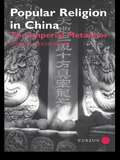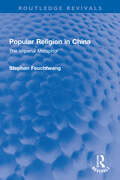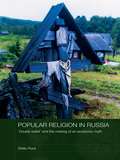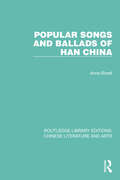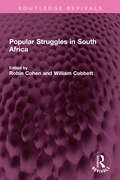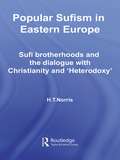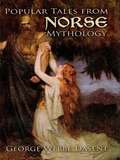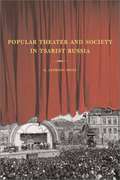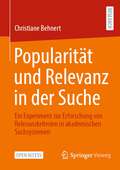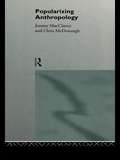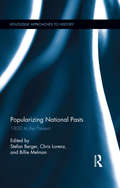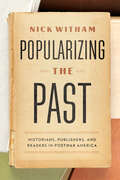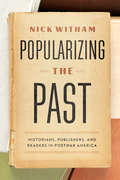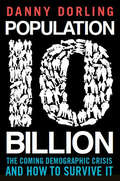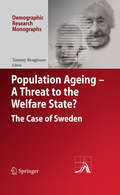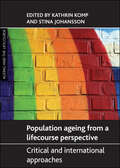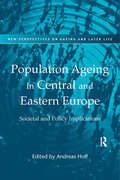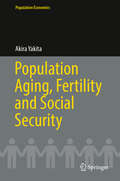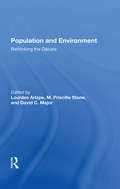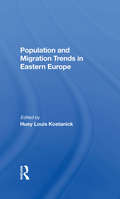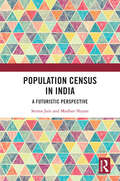- Table View
- List View
Popular Religion in China: The Imperial Metaphor
by Stephan FeuchtwangThe institution of local festivals and temples is not as well known as that of ancestor worship, but it is just as much a universal fact of Chinese life. Its content is an imperial metaphor, which stands in relation to the rest of its participants' lives as the poetry of collective vision, theatrically performed, built and painted in temples, carved and clothed in statues. Stephan Feuchtwang has brought together unpublished as well as published results of his own and other anthropologists' fieldwork in the People's Republic of China and Taiwan and put them into an historical, political and theoretical context.Students of anthropology will be intrigued. This is not a religion of a Book. Nor is it one of the named religions of China. Popular religion includes some elements of both Buddhism and the former imperial cults, more of Daoism, but it is identifiable with none of them. It is popular in the sense of being local and true of the China of the Han, or Chinese-speaking people, where every place had or has its local cults and the festivals peculiar to them. Its rites, in particular offerings of incense and fire, suggest a concept of religion. It is quite different from theories of religion based on doctrine and belief.Students of politics will also find here vital and new perspectives. Politics is never far from religion, least of all in the People's Republic of China or colonial and post-colonial Taiwan. In the People's Republic of China, there is continuing conflict between the state and the growth of congregational and lo
Popular Religion in China: The Imperial Metaphor (Routledge Revivals)
by Stephan FeuchtwangFirst published in 2001, Popular Religion in China: The Imperial Metaphor was written to bring together both the previously unpublished and published results of fieldwork in the People’s Republic of China and Taiwan and to put them into an historical, political, and theoretical context. The book presents Chinese popular religion as a distinctive institution and describes its content as an ‘imperial metaphor’. In doing so, it explores a wide range of topics, including both official and local cults, local festivals, Daoism, Ang Gong, the politics of religion, and political ritual.
Popular Religion in Russia: 'Double Belief' and the Making of an Academic Myth (Routledge Studies in the History of Russia and Eastern Europe #Vol. 10)
by Stella RockThis book dispels the widely-held view that paganism survived in Russia alongside Orthodox Christianity, demonstrating that 'double belief', dvoeverie, is in fact an academic myth. Scholars, citing the medieval origins of the term, have often portrayed Russian Christianity as uniquely muddied by paganism, with 'double-believing' Christians consciously or unconsciously preserving pagan traditions even into the twentieth century. This volume shows how the concept of dvoeverie arose with nineteenth-century scholars obsessed with the Russian 'folk' and was perpetuated as a propaganda tool in the Soviet period, colouring our perception of both popular faith in Russian and medieval Russian culture for over a century. It surveys the wide variety of uses of the term from the eleventh to the seventeenth century, and contrasts them to its use in modern historiography, concluding that our modern interpretation of dvoeverie would not have been recognized by medieval clerics, and that 'double-belief' is a modern academic construct. Furthermore, it offers a brief foray into medieval Orthodoxy via the mind of the believer, through the language and literature of the period.
Popular Songs and Ballads of Han China (Routledge Library Editions: Chinese Literature and Arts #18)
by Anne BirrellThis book, first published in 1988, compiles 77 songs and ballads (yüeh-fu) of early imperial China (200 BC – AD 300). Each song-text is newly translated and fully annotated and explicated. Dr Birrell deals systematically with problems of the earliest sources, dating, attribution, textual variants, multiforms, metre, generic title, song title and structure. This careful and thorough treatment is especially necessary for a corpus of anonymous popular texts which are often corrupt, structurally confusing, laconic and full of nonsense words and colloquialisms. Her introductory essay provides a socio-historical context for this material and charts its literary transmission, while singling out special characteristics of the genre, such as musical, oral and dramatic elements. The main text, arranged into eleven chapters plus an introduction, is supplemented by notes, appendices, maps, chronology, bibliography and index.
Popular Struggles in South Africa (Routledge Revivals)
by William Cobbett Robin Cohen‘Popular Struggles or One Struggle?’ Originally published in 1988 shortly after the miners’ strike in South Africa of 1987, this book begins with a strongly argued and seminal discussion of this question by William Cobbett and Robin Cohen. The book had an urgency and relevance at its time of original publication, but many of the themes it discusses remain as relevant today. Nearly all the contributors were close to the sites of encounter and resistance they described, but at the same time they and the editors place the individual cases within the historical context.
Popular Sufism in Eastern Europe: Sufi Brotherhoods and the Dialogue with Christianity and 'Heterodoxy' (Routledge Sufi Series)
by H T NorrisThis is a detailed description of the various Sufi orders and movements which entered into the Balkans, the Crimean peninsula and other parts of Eastern Europe following the Ottoman conquests. Many of the Sufis came from Christian societies, principally from an Eastern Orthodox background, but others, such as the Bosnians, from churches that were accused or suspected of heterodoxy of belief and of antinomianism. These beliefs, together with pre-Christian beliefs, influenced by Manicheanism, Dualism and pantheism, left their mark on Sufi Islam. The book concentrates on the Bosnians, Bulgarians, Albanians and Tatars. Their Sufism reflects their national aspirations, and their writings fuse their mysticism, national faith and folklore in a Sufism which is quite distinct from that in other regions of the Muslim world.
Popular Tales from Norse Mythology
by George Webbe DasentEmbodying the fears, fantasies, and forebodings of the people who lived in northern Europe when the world was a darker and more frightening place, these 42 authentic folktales were culled from the rich legacy of Norse and German mythology by noted folklorist George Webbe Dasent. They include stories of princes and princesses who have been transformed into animals, trolls, and maneating giants who possess magical powers, and good-hearted, clever young men and women, often poor and ridiculed, who eventually come away with wealth and love beyond measure.In addition to such well-known favorites as "Dapplegrim," "Katie Woodencloak," "Tatterhood," and "Legend of Tannhäuser," this collection also brings to light many gems difficult to find elsewhere. In "The Werewolf," a cruel stepmother thwarts a beautiful princess's marriage plans by transforming her fiancé into a hunted denizen of the forest. The hilarious "Such Women Are" proves the world is never without a sufficiency of fools, while "The Three Dogs" tells of a youth whose four-legged friends defeat a serpent with the nasty habit of devouring a town's young women. Among many other hard-to-find stories are "King Gram," "The Magician's Pupil," "The Outlaw," "Temptations," "The Widow's Son," "The Three Sisters Trapped in a Mountain," and "The Goatherd" (the inspiration for Washington Irving’s story of Rip van Winkle).These stories preserve the ancient myths of Western Europe that have been passed down from generation to generation, but aside from their importance as seminal folktales, they are simply good reading — full of passion and excitement, magic, mystery, and sheer storytelling power. Popular Tales from Norse Mythology will delight any student or admirer of myths and mythology.
Popular Television in Eastern Europe During and Since Socialism (Routledge Advances in Internationalizing Media Studies)
by Anikó Imre Timothy Havens Katalin LustyikThis collection of essays responds to the recent surge of interest in popular television in Eastern Europe. This is a region where television's transformation has been especially spectacular, shifting from a state-controlled broadcast system delivering national, regional, and heavily filtered Western programming to a deregulated, multi-platform, transnational system delivering predominantly American and Western European entertainment programming. Consequently, the nations of Eastern Europe provide opportunities to examine the complex interactions among economic and funding systems, regulatory policies, globalization, imperialism, popular culture, and cultural identity.This collection will be the first volume to gather the best writing, by scholars across and outside the region, on socialist and postsocialist entertainment television as a medium, technology, and institution.
Popular Theater and Society in Tsarist Russia
by E. Anthony SwiftA detailed and fascinating account of the emergence of popular theater in Russia out of a synthesis of fairground shows, elite theater tradition, folk performance, and the new possibilities of mass culture. Swift shows how the public seized upon theater as an art form, as entertainment, and as an instrument of popular education.
Popularität und Relevanz in der Suche: Ein Experiment zur Erforschung von Relevanzkriterien in akademischen Suchsystemen
by Christiane BehnertIn diesem Open-Access-Buch wird mithilfe eines großangelegten Online-Experiments untersucht, wie sich die Anzeige von Zitationen oder Downloads auf die Relevanzbewertung in akademischen Suchsystemen auswirkt. Bei der Suche nach Informationen verwenden Menschen diverse Kriterien, anhand derer sie die Relevanz der Suchergebnisse bewerten. In diesem Buch wird erstmals eine systematische Übersicht über die Einflüsse im Prozess der Relevanzbewertung von Suchergebnissen in akademischen Suchsystemen aufgezeigt. Zudem wird ein anspruchsvolles und komplexes Methodenframework zur experimentellen Untersuchung von Relevanzkriterien vorgestellt. Dieses eignet sich für die weitergehende Erforschung von Relevanzkriterien im informationswissenschaftlichen Bereich.
Popularizing Anthropology
by Jeremy MacClancy Chris McDonaughAnthropology written for a popular audience is the most neglected branch of the discipline. In the 1980s postmodernist anthropologists began to explore the literary and reflective aspects of their work. Popularizing Anthropology advances that trend by looking at a key but previously marginalized genre of anthropology.The contributors, who are well known anthropologists, explore such themes as: why so many anthropologists are women; how the Japanese have reacted to Ruth Benedict; why Margaret Mead became so successful; how the French media promote Levi-Strauss and Louis Dumont; Why Bruce Chatwin tells us more about Aboriginals than many anthropologists in Australia; how personal accounts of fieldwork have evolved since the 1950s; how to write a personal account of fieldwork.Popularizing Anthropology unearths a submerged tradition within anthropology and reveals that, from the beginning, anthropologists have looked beyond the boundaries of the academy for their listeners. It aims to establish the popularization of the discipline as an illuminating topic of investigation in its own right, arguing that it is not an irrelevant appendage to the main body of the subject but has always been an integral part of it.
Popularizing National Pasts: 1800 to the Present (Routledge Approaches to History)
by Stefan Berger Chris Lorenz Billie MelmanPopularizing National Pasts is the first truly cross-national and comparative study of popular national histories, their representations, the meanings given to them and their uses, which expands outside the confines of Western Europe and the US. It draws a picture of popular histories which is European in the full sense of this term. One of its fortes is the inclusion of Eastern Europe. The cross-national angle of Popularizing National Pasts is apparent in the scope of its comparative project, as well as that of the longue durée it covers. Apart from essays on Britain, France, and Germany, the collection includes studies of popular histories in Scandinavia, Eastern and Southern Europe, notably Romania, Bulgaria, Croatia, Armenia, Russia and the Ukraine, as well as considering the US and Argentina. Cross-national comparison is also a central concern of the thirteen case studies in the volume, which are, each, devoted to comparing between two, or more, national historical cultures. Thus temporality –both continuities and breaks- in popular notions of the past, its interpretations and consumption, is examined in the long continuum. The volume makes available to English readers, probably for the first time, the cutting edge of Eastern European scholarship on popular histories, nationalism and culture.
Popularizing the Past: Historians, Publishers, and Readers in Postwar America
by Nick WithamPopularizing the Past tells the stories of five postwar historians who changed the way ordinary Americans thought about their nation’s history. What’s the matter with history? For decades, critics of the discipline have argued that the historical profession is dominated by scholars unable, or perhaps even unwilling, to write for the public. In Popularizing the Past, Nick Witham challenges this interpretation by telling the stories of five historians—Richard Hofstadter, Daniel Boorstin, John Hope Franklin, Howard Zinn, and Gerda Lerner—who, in the decades after World War II, published widely read books of national history. Witham compellingly argues that we should understand historians’ efforts to engage with the reading public as a vital part of their postwar identity and mission. He shows how the lives and writings of these five authors were fundamentally shaped by their desire to write histories that captivated both scholars and the elusive general reader. He also reveals how these authors’ efforts could not have succeeded without a publishing industry and a reading public hungry to engage with the cutting-edge ideas then emerging from American universities. As Witham’s book makes clear, before we can properly understand the heated controversies about American history so prominent in today’s political culture, we must first understand the postwar effort to popularize the past.
Popularizing the Past: Historians, Publishers, and Readers in Postwar America
by Nick Witham“Those dispirited by today’s skirmishes over the American past should seek out Nick Witham’s wonderful book on postwar history writing.” —Sarah E. Igo, author of The Averaged AmericanWhat’s the matter with history? For decades, critics of the discipline have argued that the historical profession is dominated by scholars unable, or perhaps even unwilling, to write for the public. In Popularizing the Past, Nick Witham challenges this interpretation by telling the stories of five historians—Richard Hofstadter, Daniel Boorstin, John Hope Franklin, Howard Zinn, and Gerda Lerner—who, in the decades after World War II, published widely read books of national history.Witham compellingly argues that we should understand historians’ efforts to engage with the reading public as a vital part of their postwar identity and mission. He shows how the lives and writings of these five authors were fundamentally shaped by their desire to write histories that captivated both scholars and the elusive general reader. He also reveals how these authors’ efforts could not have succeeded without a publishing industry and a reading public hungry to engage with the cutting-edge ideas then emerging from American universities. As Witham’s book makes clear, before we can properly understand the heated controversies about American history so prominent in today’s political culture, we must first understand the postwar effort to popularize the past.“Astute, informative, and skillfully researched, Witham’s thought-provoking analysis will appeal to historians (and aspiring historians) who want a better grasp on the challenges and opportunities of history as a profession and the business of popular-history books.” ―Library Journal
Population 10 Billion
by Danny DorlingBefore May 2011 the top demographics experts of the United Nations had suggested that world population would peak at 9.1 billion in 2100, and then fall to 8.5 billion people by 2150. In contrast, the 2011 revision suggested that 9.1 billion would be achieved much earlier, maybe by 2050 or before, and by 2100 there would be 10.1 billion of us. What's more, they implied that global human population might still be slightly rising in our total numbers a century from now. So what shall we do? Are there too many people on the planet? Is this the end of life as we know it?Distinguished geographer Professor Danny Dorling thinks we should not worry so much and that, whatever impending doom may be around the corner, we will deal with it when it comes. In a series of fascinating chapters he charts the rise of the human race from its origins to its end-point of population 10 billion. Thus he shows that while it took until about 1988 to reach 5 billion we reached 6 billion by 2000, 7 billion eleven years later and will reach 8 billion by 2025. By recording how we got here, Dorling is able to show us the key issues that we face in the coming decades: how we will deal with scarcity of resources; how our cities will grow and become more female; why the change that we should really prepare for is the population decline that will occur after 10 billion.Population 10 Billion is a major work by one of the world's leading geographers and will change the way you think about the future. Packed full of counter-intuitive ideas and observations, this book is a tool kit to prepare for the future and to help us ask the right questions
Population 10 Billion
by Professor Danny DorlingBefore May 2011 the top demographics experts of the United Nations had suggested that world population would peak at 9.1 billion in 2100, and then fall to 8.5 billion people by 2150. In contrast, the 2011 revision suggested that 9.1 billion would be achieved much earlier, maybe by 2050 or before, and by 2100 there would be 10.1 billion of us. What's more, they implied that global human population might still be slightly rising in our total numbers a century from now. So what shall we do? Are there too many people on the planet? Is this the end of life as we know it?Distinguished geographer Professor Danny Dorling thinks we should not worry so much and that, whatever impending doom may be around the corner, we will deal with it when it comes. In a series of fascinating chapters he charts the rise of the human race from its origins to its end-point of population 10 billion. Thus he shows that while it took until about 1988 to reach 5 billion we reached 6 billion by 2000, 7 billion eleven years later and will reach 8 billion by 2025. By recording how we got here, Dorling is able to show us the key issues that we face in the coming decades: how we will deal with scarcity of resources; how our cities will grow and become more female; why the change that we should really prepare for is the population decline that will occur after 10 billion.Population 10 Billion is a major work by one of the world's leading geographers and will change the way you think about the future. Packed full of counter-intuitive ideas and observations, this book is a tool kit to prepare for the future and to help us ask the right questions
Population Ageing - A Threat to the Welfare State?: The Case of Sweden
by Tommy BengtssonThis book is the first to take a comprehensive view of the challenges that population ageing present in the near future taking Sweden as the case. Can the increasing number of retirees per worker be stopped by immigration or increasing fertility or will we need to increase pension age instead? Cost for the social-care system is readily increasing; even more is the costs for health care. Can the galloping costs be funded by an increase in taxes or do we need to make reforms, similar to the ones already made in the pension system, which has been used as a model for many other countries. The fact that it is difficult to make health care dependent on personal contributions, as is the case of the pension system, funding of health care is a true test of solidarity across generations. The book ends with a discussion on whether the demographic challenge to the welfare system is also a threat to the welfare state as such.
Population Ageing from a Lifecourse Perspective: Critical and International Approaches (Ageing and the Lifecourse)
by Edited by Kathrin Komp and Stina JohanssonPopulations around the globe are ageing rapidly. This demographic shift affects families, market structures and social provisions. This timely volume, part of the Ageing and the Lifecourse series, argues that the lifecourse perspective helps us understand the causes and effects of population ageing. The lifecourse perspective suggests that individuals’ experiences at an early age can influence their decisions and behaviour at a later age. This much-needed volume combines insights from different disciplines and real-life experiences to describe the theories and practices behind this idea. It therefore caters to the needs of scholars, practitioners and policy makers in a range of areas including sociology and political science.
Population Ageing in Central and Eastern Europe: Societal and Policy Implications (New Perspectives On Ageing And Later Life Ser.)
by Andreas HoffDuring the 1990s, Europe became the first continent with a 'mature society', where people aged 60 years and older outnumber children and as this trend continues, the resulting 'ageing societies' will differ from previous societies in their make-up, in their needs, and in their resource allocation. Population ageing poses an even greater challenge to the post-communist societies of Central and Eastern Europe. While still struggling to cope with the aftermath of the economic and social transition process following the breakdown of communism, they are now facing even more rapid demographic change than Western Europe. This book brings together leading scholars to present an understanding of the processes underlying the very rapid population ageing in Central and Eastern Europe. In addition to discussing the main demographic drivers behind this development in each of the countries examined, this volume also discusses its implications for policy, healthcare provision, workforces, intergenerational family relations, the social cohesion of future Central and Eastern European societies, and the quality of life experienced by their citizens. Organised around broad geographical regions with final sections analysing the book's findings and their future implications, Population Ageing in Central and Eastern Europe will be of interest to gerontologists, policy makers, students and scholars of population change
Population Aging and Age-Friendly Transport in China (Population, Regional Development and Transport)
by Pengjun Zhao Jinxin XieThis book is the first book that investigates aging and its impacts on transport system in China. Using various data, this book covers, but is not limited to, the development of population aging, the changes of travel demand, the features of travel behavior of China’s elderly, progress and prospect of age-friendly transport in China. The book has international academic novelty in three points. Firstly, it discovers the long-term supply-demand relationship between population aging and transport infrastructure development. Secondly, it finds the changes and factors in travel behavior of the elderly people. Thirdly, it discusses the advantages or disadvantages of age-friendly transport policy. The findings in the book provide fresh evidences for the challenges posed by aging to transport and enhance readers’ existing knowledge of the elderly people’s travel behavior and the related determinants. These findings are helpful for planners and politicians to make age-friendly transport policies and useful for investors and enterprises to supply proper transport services to the elderly people. This book is of great interest to scholars and practitioners interested in transport development, transport policy, social transition, sustainable mobility, urban planning, urban governance and is relevant to China and other developing countries.
Population Aging and Housing Diversity in Poland: The Importance of Aging in the Right Place (International Perspectives on Aging #44)
by Greta E. GarnissThis book provides new and original insight on the senior living housing needs in Poland. It focuses on housing needs of the 60-74 age group that are generally more mobile and not in need of services offered in care homes. The book not only shows that seniors prefer to live independently as long as possible, but also touches upon their primary conditions for this, such as properties near goods, services and social networks, in modern buildings that have common amenities that meet their needs as they age. The book also discusses the transformation of economic, social and cultural changes leading to the creation of a new housing options for younger seniors living in many cities in Poland. With the book concluding that there is need for more diverse housing choice for senior living than is currently available, it provides an interesting read for academics, professionals and local, regional and national social service agencies that work with seniors.
Population Aging, Fertility and Social Security
by Akira YakitaThis book provides a comprehensive, theory-based analysis of current issues in population economics. It addresses the most important problems caused by demographic changes using the popular overlapping generations growth model by Samuelson and Diamond. Taking into account families' fertility decisions, it examines not only the demographic changes due to longer life expectancy but also the effects of social security policy on demography and labor supply/individual retirement behaviors. Conducting all analyses in a dynamic general equilibrium setting, the book offers a valuable theoretical reference guide in the field of population economics.
Population And Environment: Rethinking The Debate
by Lourdes Arizpe David Major M. Priscilla Stone Priscilla StoneThis ambitious interdisciplinary volume places population processes in their social, political, and economic contexts while it considers their environmental impacts. Examining the multi-faceted patterns of human relationships that overlay, alter, and distort our ties to urban and rural landscapes, the book focuses especially on the essential experi
Population And Migration Trends In Eastern Europe
by Huey L KostanickEastern Europe is undergoing broad changes in demographic structure that have widened the ranges of population growth between countries and have created new problems of worker movement. This book, the result of a conference on demography and urbanization in Eastern Europe, contains both broad theoretical and conceptual essays and specific analyses
Population Census in India: A Futuristic Perspective
by Seema Jain Madhav ShyamThe population census is the primary data source for any demographic analysis, the execution of social and economic development programmes, administrative activity, as well as for policy decisions, special surveys and scientific research. This book critically analyses key facets of pre-census activity, including its timing, duration and method of enumeration. It traces concepts and definitions adopted by the census of India back to its beginning in 1872. The authors also study themes such as census legislation, census organisation, administrative setups, training strategies, the instruction manual and the impact of COVID-19 on the census.The volume will be indispensable for students and researchers of population studies, history, development studies, human geography, anthropology, public policy and governance, migration studies and South Asian studies. It will also be useful for planners and policymakers.
